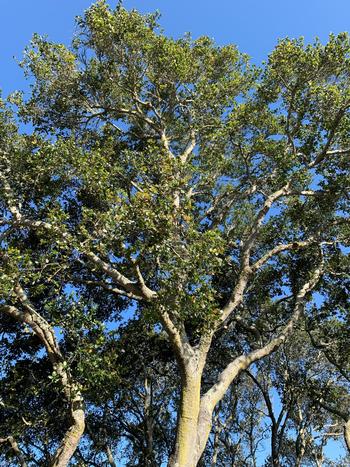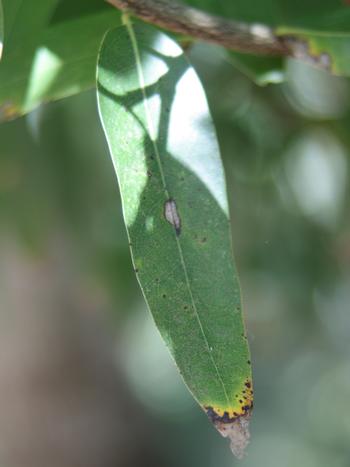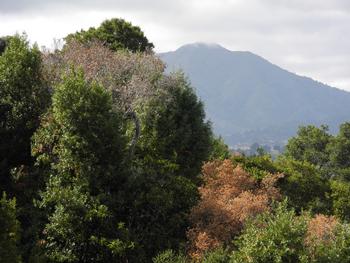Keeping California oaks healthier
-
Anne-Marie Walker
-
Shortly before the year 2000, California oaks began dying. The University of California launched an investigation. What was causing this plague, and how might California oaks be kept healthier? A water-borne organism, Phytophthora ramorum, was found to be the culprit. Derived from Greek and Latin, it means plant destroyer. To better understand how it works and how to mitigate it, the DNA of Phytophthora ramorum was sequenced. This allowed the UC team to develop rapid diagnosis and to trace the origin of imported nursery stock. As death of an infected tree can come quickly, the disease was given the acronym Sudden Oak Death (SOD). It is also a little easier to say.
 A healthy coast live oak tree, an iconic native in the California landscape. Photo: David S. Walker
A healthy coast live oak tree, an iconic native in the California landscape. Photo: David S. WalkerPhytophthora ramorum has infected over 100 species in the coastal mixed-evergreen forests of California. You can visit the California Oak Mortality Task Force website to see the list of impacted species; www.sudenoakdeath.org. The infection has killed tens of millions of trees in California. The University trained Citizen Science volunteers to conduct spring field sample surveys called Blitzes. Results help track the disease, predict emerging disease risk, and make disease management recommendations. The University developed a new tool for homeowners to predict the risk of SOD in their neighborhood. The SODmap mobile is an application available for free on your iPhone from the iTunes store or on the Android iOS at Google Play. The app can be used to visualize the distribution of trees tested for SOD. The app can also be used to determine the risk for oak infection at the user’s location. The app shows the distribution of SOD-positive and SOD-negative trees based on the lab results obtained from samples collected in the Blitz.
Recently, the University of California released results of the 2023 SOD Blitz survey along with revised recommendations for combating, mitigating, and managing SOD. Two major concerns about SOD have emerged. First, because the disease spreads when it rains, and spring rains occurred in 2023, an uptick in SOD incidence may occur. While rain is welcome news for the suppression of wildfires, the wet weather is an alert to vigilance about SOD. Second, another variant of Phytophthora ramorum has emerged in California forests. This variant is EU1, and it has the potential to be even more deadly than the NA1 variant. There are four genetic lineages of Phytophthora ramorum, each named for the continent on which it was first described and in the order of its discovery (NA1, NA2, EU1, and EU2). Previously, only NA1 (North America 1) was found in California wildland forests. Now EU 1 (Europe 1) is also present, further increasing concern about SOD’s impact on California forests. If the EU1 variant is detected near you, the State of California and the Federal Government will try to eradicate it at no or minimal cost to homeowners, but only if detection occurs early. If you believe you detect symptoms of SOD in your neighborhood, contact a tree care specialist. Oregon’s battle against Phytophthora ramorum variants is on the website listed above. SOD symptomatic California Bay Laurel leaf from which spored can travel to oaks. Photo: Steven Swain, UCCEBased on the 2023 SOD Blitz survey, revised recommendations for combating, mitigating, and managing SOD have been developed, including injection of phosphonate in the fall once every two years and adherence to new reduced concentrations of phosphonate. Recommendations for topical bark applications of phosphonate remain unchanged and should continue to be applied annually, preferably in the fall but possibly also in late winter. For more details, go to www.sodblitz.org. Managing Sudden Oak Death is a 3-step process: First- use the SODmap mobile app. Second – use the graph to determine your level of risk of SOD. Third- Remember to apply phosphonate to oaks in the fall. These are actionable items we can take to keep our California oaks healthier.
SOD symptomatic California Bay Laurel leaf from which spored can travel to oaks. Photo: Steven Swain, UCCEBased on the 2023 SOD Blitz survey, revised recommendations for combating, mitigating, and managing SOD have been developed, including injection of phosphonate in the fall once every two years and adherence to new reduced concentrations of phosphonate. Recommendations for topical bark applications of phosphonate remain unchanged and should continue to be applied annually, preferably in the fall but possibly also in late winter. For more details, go to www.sodblitz.org. Managing Sudden Oak Death is a 3-step process: First- use the SODmap mobile app. Second – use the graph to determine your level of risk of SOD. Third- Remember to apply phosphonate to oaks in the fall. These are actionable items we can take to keep our California oaks healthier. Dying oaks in Marin County near Mount Tamalpais, Photo: Anne-Marie Walker
Dying oaks in Marin County near Mount Tamalpais, Photo: Anne-Marie Walker



